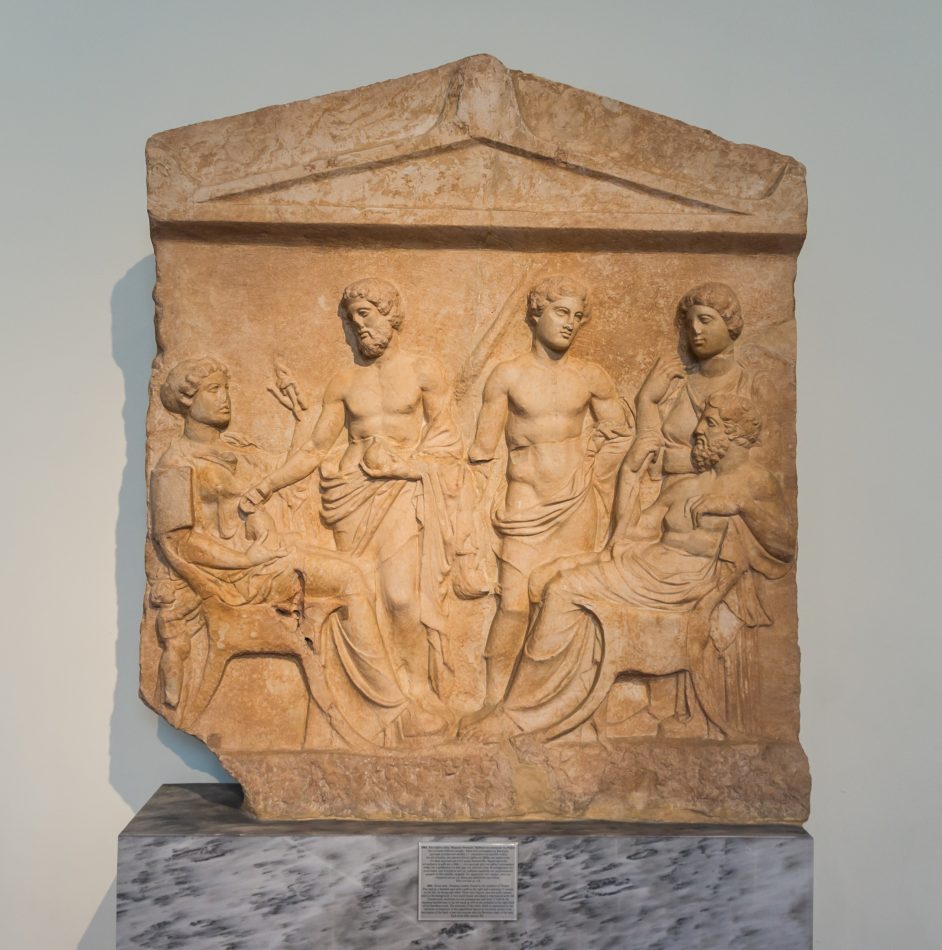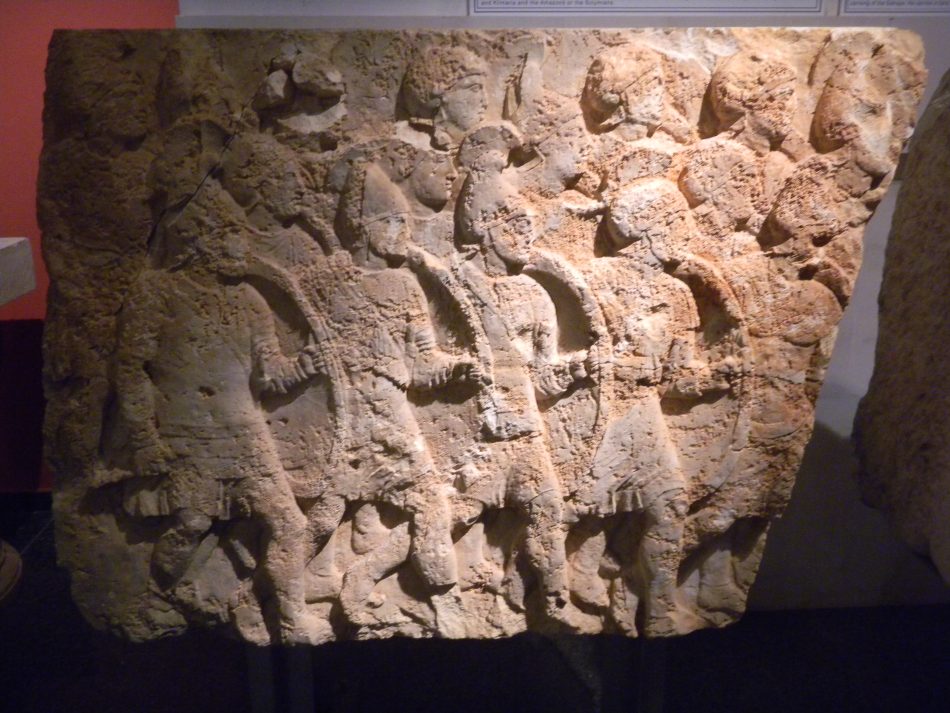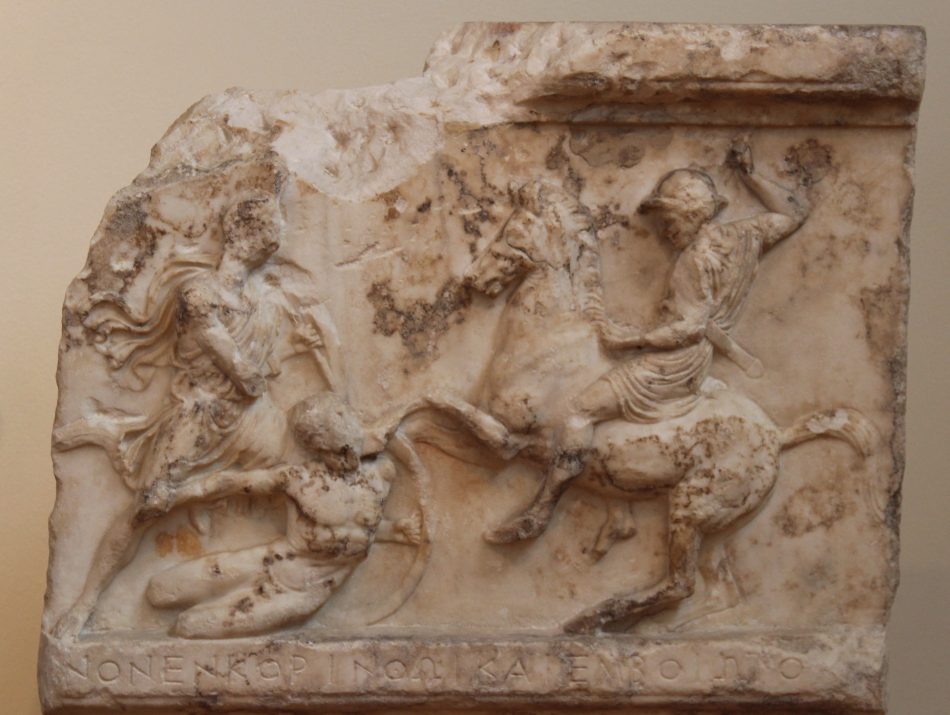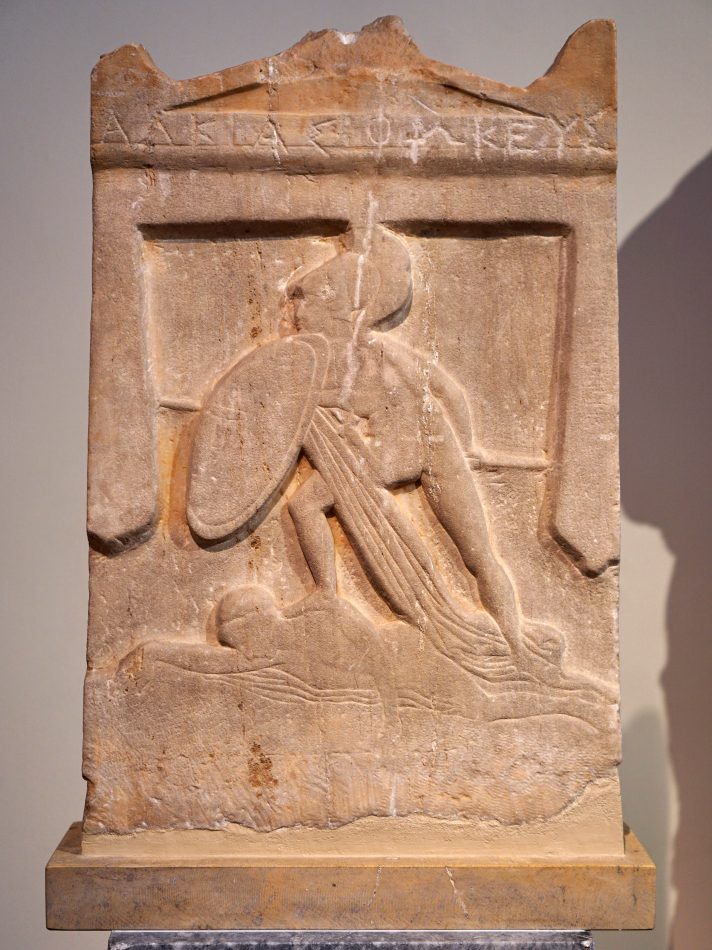"It's just a jump to the left" - The left-most position in ancient hoplite battle
Yet again a quick idea for a blog has ballooned into a massive undertaking (8,000 words and counting) and this blog is now a summary of that much larger, ever growing, piece. What follows therefore is a summary of, and the conclusions reached after, some rather dense argument. My original idea stemmed from the fact that in most ancient Greek battles, the position of honour in a hoplite formation was on the right of the battle line (Herodotus 6.111.1, 9.26.1-28.6, 9.46.3, Thucydides 5.67.1-2, Xenophon Hellenica 4.2.20). In several cases, such as the battles of Marathon, Plataea, and Mantinea in 418, we also have evidence of who was stationed on the left of the line in what was considered the second-most honourable position (the Plataeans at Marathon, Athenians at Plataea and Mantinea – see, for instance, Herodotus 9.26.1-28.1 for the debate between the Athenians and Tegeans as to who should have the right of holding the left before Plataea - the Spartans holding the right-most position had already been established / accepted). It is surprising how often we are only told who was stationed on the right and who the left of a battle line – the units making up the centre (and certainly their order in any more detail) are considered relatively unimportant to several of our historians. Within their own battle line (such as for the Athenians at Marathon or the Spartans) the position of honour was also on the right-most station.
 Photo (right): A late 5th century Boeotian grave stele showing a bearded man and beardless youth - perhaps an erastes and eromenos - lover and beloved - photo Giovanni Dall'Orto
Photo (right): A late 5th century Boeotian grave stele showing a bearded man and beardless youth - perhaps an erastes and eromenos - lover and beloved - photo Giovanni Dall'Orto
The Thebans
The traditional right-most station in the line = most honourable place was challenged by the Thebans in the 4th century BC. At both Leuctra and Mantinea in 362, the Thebans themselves were stationed on the left of the line opposite the Spartan contingent on the right of their own line (Diodorus 15.85.2). This was a deliberate tactic to target the Spartan contingent but, despite its success, we find the traditional station back in place soon after. At Mantinea in 362, the Spartans were on the right while the Athenians were once again on the left – a sign, once more, of their position in the second most important place. We also find that the position on the right was re-established by Philip II of Macedon who always took position there (Diodorus 16.4.5, Frontinus Strategemata 2.3.2). Although Alexander would command his Companion cavalry in his famous battles, these too were stationed on the right of the phalanx at the Granicus, the Issus and Gaugamela. At the battle of Chaeronea in 338 BC, Philip was on the right wing and Alexander on the left wing of the Macedonian army (Diodorus 16.86.1) and it is the forces opposing them which give us a jumping-off point (pun intended) to explore the position of honour changing from the accepted norm in some circumstances. We do not know with any certainty where the Theban general stood in the Theban line at Leuctra, Mantinea, or Chaeronea. At Tegyra in 375 BC we are told Pelopidas placed himself opposite the Spartan commanders Gorgoleon and Theopompus (Pelopidas 17.3). The two Spartan commanders were together in the front line, most probably in the right-most of the two morai of the Spartans which Pelopidas faced. This implies that Pelopidas' entire small force was massed on the left. At Mantinea, Epaminondas led and threw his javelin at the Spartan commander (Diodorus 15.86.4) which implies that he too was close to the left-most position to do so although we might argue he was in the centre of those forces massed on the left too. The exact dispositions of the Thebans at Leuctra are fiercely debated. It would seem, however, that the Theban commanders stationed themselves on the left or in the centre of their own contingent, but not on the right of that formation.
Knowing your left from your right
In many battles, the forces present, sometimes on both sides, were composed of an alliance of contingents from various cities and states. In such cases, the most important contingent was stationed on the right (such as the Spartans at Plataea). Occasionally, the position on the right was taken by the men in whose territory the battle was being fought. Callimachus at Marathon was from the tribe of Aiantis which was also the tribe of the deme of Marathon for instance. At Mantinea in 418, the Mantineans themselves took position on the right of the allies because the battle was being fought in their territory; on the Spartan side, although there were a few Spartan troops in the right-most position to maintain their honour, the Tegeans were next to them on the right wing (the battle was fought close to Tegea). The position of the seven Spartan lochoi in the battle was on the left of the line although this was essentially the centre (Thucydides 4.67.1). And in that Spartan contingent, the Spartan king himself, Agis II, was on the right – Thucydides 5.72.4. At Mantinea in 362, the Mantineans were next to the Spartans on the right (Diodorus 15.85.2 - "the Mantineans with the rest of the Arcadians occupied the right wing with the Lacedaemonians as their neighbours and supporters" – although it is unclear from this whether the Spartans of Mantineans were on the extreme right – given the Theban attack on the Spartans themselves, the Spartans were most probably right-most. When we look closely at four battles (the only ones where there is enough evidence to argue for what follows), however, we see that, in some circumstances, the position of honour in an allied contingent placed on the left of a line of battle was, in fact, in the left-most position, not the right-most. Like Agis II at Mantinea in 418, a position of honour on the right of your own contingent would, in fact, place you in the centre of an allied army – perhaps hardly an honourable position at all. The battles we can use to explore this circumstance are the battles of Nemea (394 BC), Mantinea (both 418 and 362 BC) and the battle of Chaeronea (338 BC). Here, however, there is only space to explore two (the two with the most compelling evidence – Nemea and Mantinea in 418 – perhaps we can explore the other two in a later blog - if you would like that, please comment below). All these battles involve Athens and, at all four battles, Athens, as the second-most honoured contingent, was stationed on the left of the allied line. Within that line, however, it would seem that the Athenian commanders (who traditionally would be stationed on the right like Callimachus was at Marathon (Herodotus 6.111.1)), were in fact, stationed in the left-most position of their own battle line.
 Photo (right): Phalanx depicted on the tomb of Pericles of Lycia, early 4th century BC - photo Elisa Triolo
Photo (right): Phalanx depicted on the tomb of Pericles of Lycia, early 4th century BC - photo Elisa Triolo
When is your left your right?
Our best evidence of this phenomenon comes from the battle of Nemea in 394 BC although not from one of the historical narratives of the battle. Rather, it comes from a speech by the orator Lysias in defence of Mantitheus, who fought at the battle: For Mantitheus/Oration 16. At the battle of Nemea in 394 BC (Xenophon Hellenica 4.2.16-23, Diodorus 14.83.1-2), Lysias tells us (in the voice of Mantitheus) that Mantitheus took his place in the front rank at the battle (Lysias 16.15) and that "our tribe had the worst fortune, and suffered the heaviest losses." Mantitheus was apparently from the tribe of Pandionis and fought in their taxis, one of the ten into which all Athenian armies were divided. Mantitheus then claims that he retired from the field "later than the fine fellow of Steiria," by which Lysias must mean Thrasybulus who was from that deme (Hellenica 4.8.25). He is usually claimed to be the Athenian strategos at the battle. Steiria was indeed in the tribe of Pandionis. No source names another strategos at Nemea, although the evidence of Thrasybulus’ command is slight and comes from the same Lysias chapter – where he goes on to say that Thrasybulus was "reproaching everybody with cowardice." Both Robert J. Buck (Historia 120 (1998): 101-105) and Robin Seager (JHS 87 (1967): 99n.33) consider that Thrasybulus was overall Athenian strategos at both the battles of Nemea and Coronea, the latter fought only a month later (but where the Athenians did not occupy the left-most position of the allied line). Lysias does not name Thrasybulus or call him the overall commander but there is no evidence of any other commander at the battle – Lysias does, however, mention plural commanders (archonton) at 16.16. Aristophanes' Ecclesiazusae (Assemblywomen), lines 195-202, also implies that Thrasybulus was the commander, the line criticising him for suggesting the alliance with Thebes and fleeing the city after defeat.

Athenian funeral stele (the demosion sema or public grave) of the war dead form the Corinthian War - photo Gary Todd
It would seem then, that Mantitheus was from the same tribe as Thrasybulus, the commander of the Athenian army. And this seems to be the point Lysias is making. For this tribe to have suffered the heaviest losses in the battle, however, it needed to be positioned on the left of the Athenian line (not on the right where we might expect it to have been stationed if Thrasybulus was strategos). The position of Pandionis on the left is corroborated by Xenophon’s account of the battle where the Spartans surrounded the Athenian left wing (Hellenica 4.2.20) and the men on the Athenian right suffered only slightly (Hellenica 4.2.21). The evidence of Lysias, therefore, definitively places Pandionis on the left of the Athenian line and if Thrasybulus was the commander on that day, then he was stationed on the left of the line, not the right. According to Xenophon, Athens fielded 6,000 hoplites at Nemea (Hellenica 4.2.17) and, on the Athenian left, the Spartans and Tegeans opposite them (on their own right) extended beyond their line (Hellenica 4.2.20-21). The Spartans charged "upon their adversaries, wheeling round their overlapping wing in order to surround them" (Hellenica 4.2.20). The men on the Athenian right (where we might expect the strategos to be stationed), suffered only lightly coming only against the Tegeans. Xenophon continues that (Hellenica 4.2.21):
"the Lacedaemonians themselves overcame that part of the Athenians which they covered, and wheeling round with their overlapping wing killed many of them, and then, unscathed as they were, marched on with lines unbroken. They passed by the other four tribes of the Athenians before the latter had returned from the pursuit, so that none of these were killed except such as fell in the original encounter, at the hands of the Tegeans."
The evidence of Lysias, therefore, corroborates Xenophon's account and places Mantitheus on the left of the Athenian line suffering the most casualties with the Pandionis taxis. Diodorus gives us 2,800 casualties on the side of the Athenians and their allies although we get no more specific number for the Athenians themselves. Each taxis in the Athenian army would have contained roughly 600 men and Xenophon suggests that six of those taxeis suffered heavy casualties. If we assume that half the casualty numbers given were from Athens (1,400) and assign them to the six taxeis, this gives us approximately 233 men per taxis – a casualty rate of more than one third, and with most suffered by Pandionis. Lysias offers further evidence that Thrasybulus was with Pandionis on the left, stating that Mantitheus retired from the field later than Thrasybulus himself did. The units stationed on the right stayed on the field longer than those on the left, since those units were bypassed by the victorious Spartans who marched past them after the Athenian left wing (the six tribes they faced) was defeated and had fled the field. Thrasybulus may have retreated from the defeated left sooner than Mantitheus did, so Lysias’ point is only relevant if Thrasybulus was stationed on the left. If Thrasybulus was stationed on the relatively unscathed right, he would have stayed on the field longer than Lysias states. When we look to the other battles mentioned, a position of the Athenian commander on the left of the Athenian line (and left-most position of the allied line) makes more sense. When we turn to the battle of Mantinea in 418, the Athenians were again stationed on the left of the allied line (Thucydides 5.67.2). There, they faced the Spartans and Peloponnesians who, once again, outflanked their position with their own right wing. Thucydides chooses the battle of Mantinea for his lengthy and welcome digression into the command and structure of the Spartan army. Opposing the Spartans and Peloponnesian allies at Mantinea were, on the right wing, the Mantineans themselves, stationed there because the battle was being fought in their territory (Thucydides 5.67.2). Next came the Arcadian allies (we get no numbers for the Mantineans or Arcadians). Next to the Arcadians came the 1,000 elite Argives. These elite Argives were equipped and paid at public expense (Thucydides 5.67.2). Next to them were the remainder of the Argives and beyond them the men of Cleonae and Ornea, other cities of Argolis. Again, the sources give no numbers for these contingents, although earlier Thucydides (5.59.4) mentions the five generals of the Argives, perhaps suggesting a maximum of 5,000 men from Argos, the pentelochoi, or "five companies" (5.72.4). On the left of the allied line were the Athenians, with 1,000 hoplites and 300 hippeis cavalry on the extreme left of the wing. Two commanders are named for the Athenian forces, Laches and Nicostratus (Thucydides 5.61.1). It is most probable that Laches was the strategos of the 1,000 hoplites and Nicostratus the commander of the 300 hippeis (perhaps hipparchos, although he is not named as such – Thucydides uses estrategoyn of both men). If the Athenian line was drawn up in the traditional order with the position of honour on the right, we might presume that the taxis of Laches’ tribe, Cecropis, was therefore on the right of the Athenian contingent. This would, however, place him next to the Cleoneans and Orneans closer to the centre and it would seem more likely that he was stationed on the extreme left, next to the cavalry where the fighting was fiercest and where most Athenian casualties probably occurred. The reason for saying this is that both Athenian commanders fell in the battle and it seems most likely that this occurred on the left wing where the fighting was fiercest and where the Peloponnesians (the rightmost lochoi of the Spartans and probably the men of Herea) threatened to outflank the entire allied force. The other forces on the left (the Cleoneans and the Orenans and perhaps the Athenian taxeis next to them), did not wait to come to blows, but gave way as soon as the Spartans advanced (Thucydides 5.72.4). This might also imply that the Athenian commander of the day was not stationed on the right of the Athenian contingent which broke and ran. Thucydides comments (5.73.1) that the Lacedaemonian and Tegean right was closing around the Athenians with the troops that outflanked them and that the Athenians found themselves ‘between two fires’: being surrounded on one side and with their allies already defeated and retiring from the field on the other. Thucydides continues that the Athenians would have suffered more severely than any other part of the army, "but for the services of the cavalry which they had with them." Clearly, therefore, there was fierce fighting on the left of the Athenian line, much more so than on the right where the Athenian contingent was next to the Cleoneans and the Orneans. Agis, perceiving the distress of his own left wing facing the Mantineans and Argives who had been victorious (probably informed of the situation by a runner from one of the Spartan lochoi further to the left), wheeled his army and brought them to the support of his own left wing (Thucydides 5.73.2, Diodorus 12.79.5–6) rather than press his victory against the allied left wing. This manoeuvre allowed the Athenians to escape at their leisure (Thucydides 5.73.3).
 Photo (right): Late 5th century BC funeral stele of Alkias of Phocis - shown as a naked hoplite advancing over a fallen enemy (found in Corinth) - photo George E. Koronaios
Photo (right): Late 5th century BC funeral stele of Alkias of Phocis - shown as a naked hoplite advancing over a fallen enemy (found in Corinth) - photo George E. Koronaios
Thucydides gives us the casualties suffered (5.74.3): "The Argives, Orneans, and Cleonaeans had seven hundred killed; the Mantineans two hundred, and the Athenians and Aeginetans also two hundred, with both their generals." That both Laches and Nicostratus were among the 200 Athenians who fell (out of 1,300 total) strongly suggests that they were both on the left of the line, where the fiercest fighting was and where the Athenians were threatened with being enveloped. The remainder were able to escape which also implies much less fierce fighting. In which case, the strategos Laches with his tribal taxis of Cecropis may well have been stationed on the left of the Athenian line, where they were outflanked by the Peloponnesians and where they were more exposed and, understandably, where they would have suffered more casualties. At both Nemea and Mantinea in 418, therefore, there is compelling evidence (although it is not without its problems) that the commander of the second-most honoured contingent placed on the left of an allied line took his post, not on the right of his own forces, but on the left of them, stationed at the left-most point of the line. We can explore this contention for Mantinea in 362 and Chaeronea in 338 as well (a future blog beckons), and it has fascinating (and wide-reaching) ramifications for the conduct of those battles just as it does for Mantinea in 418 and Nemea in 394.




